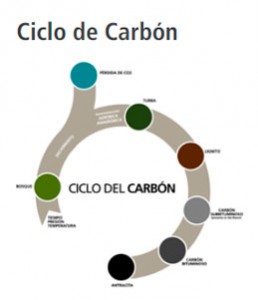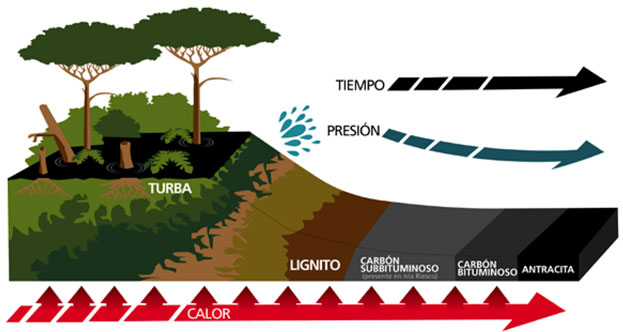Coal Formation
The coal is caused by the decomposition of terrestrial plants, leaves, wood, bark and spores that accumulate in swamps, lagoons or shallow marine areas, in a process that takes several million years.
The dead plants settled at the bottom of a basin and were covered with water and therefore, protected from air that would destroy them. Thus begins a slow transformation by the action of anaerobic bacteria, a type of microorganisms that can’t live in the presence of oxygen.

On a scale of millions of years a progressive enrichment in carbon occurs, given the loss of water and oxygen; Added to that the loss of hydrogen (aromatization). Later they can be covered with clay deposits, which will help to the maintenance of the anaerobic environment, suitable to continue the process of coalification
In the coalfields, the coal layers are interleaved with other layers of sedimentary rocks such as sandstones, clays, conglomerates and, in some cases, metamorphic rocks such as shales and slates
Geologists explain that the large deposits of coal began to form only after the evolution of plants, 400 million years ago.
During the Carboniferous period (350 to 280 million years) accumulations in the Northern Hemisphere occurred; while during the Permian – Carboniferous period (350 to 225 million years) in the Southern Hemisphere and most recently, at the end of the Cretaceous, Paleogene and early Neogene (100 to 15 million years) in such diverse areas as the United States, South America, Indonesia and New Zealand.

- Time.
- Pressure.
- Peat.
- Lignite.
- Subbituminous coal.
- Bituminous coal.
- Anthracite.
- Heat.
Among fossil fuels, coal is by far the most abundant in the world. Not only are large reserves, but they are also geographically scattered in more than 100 countries on all continents. Some studies indicate that the current relations of coal reserves are approximately 4 times that of the oil. Coal, as an energy source, satisfies diverse markets: power generation, steel manufacturing, cement, and various industrial processes requiring heat. In developing countries, domestic use for heating and cooking is also important


